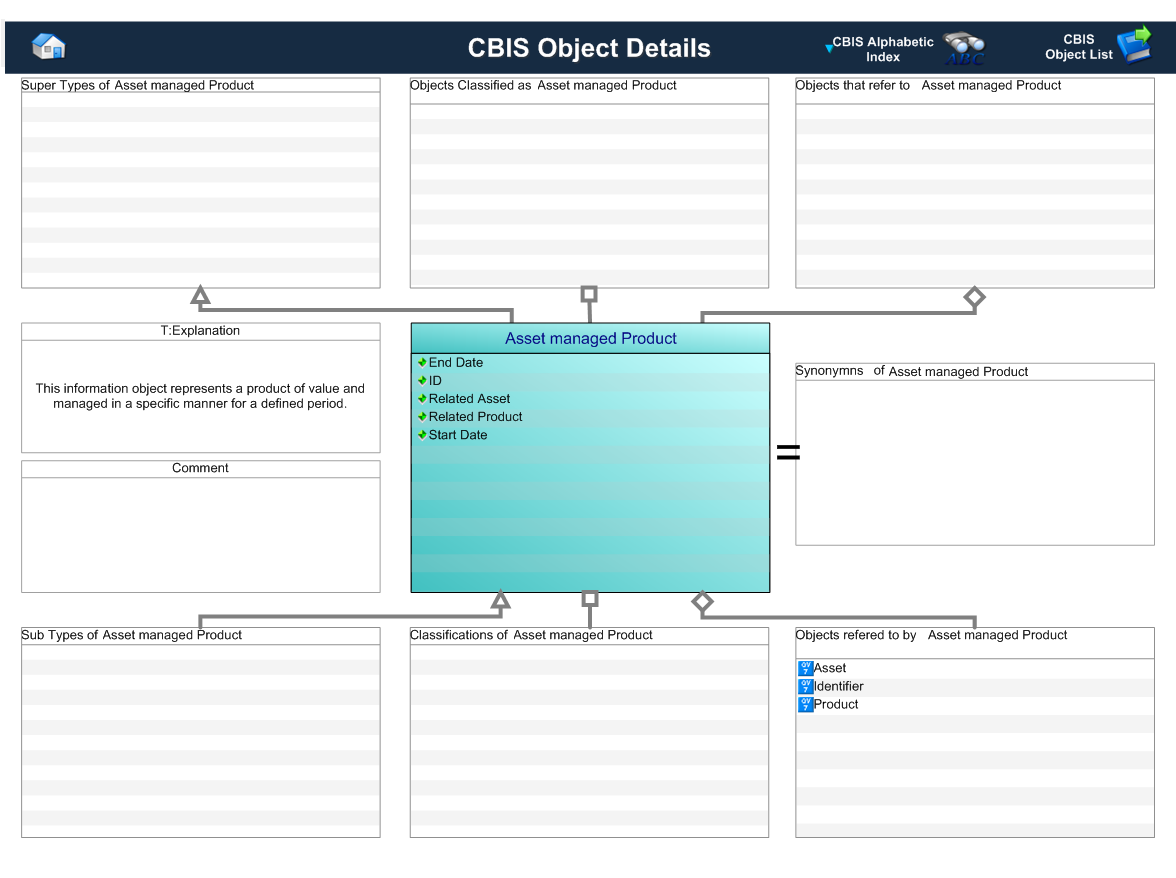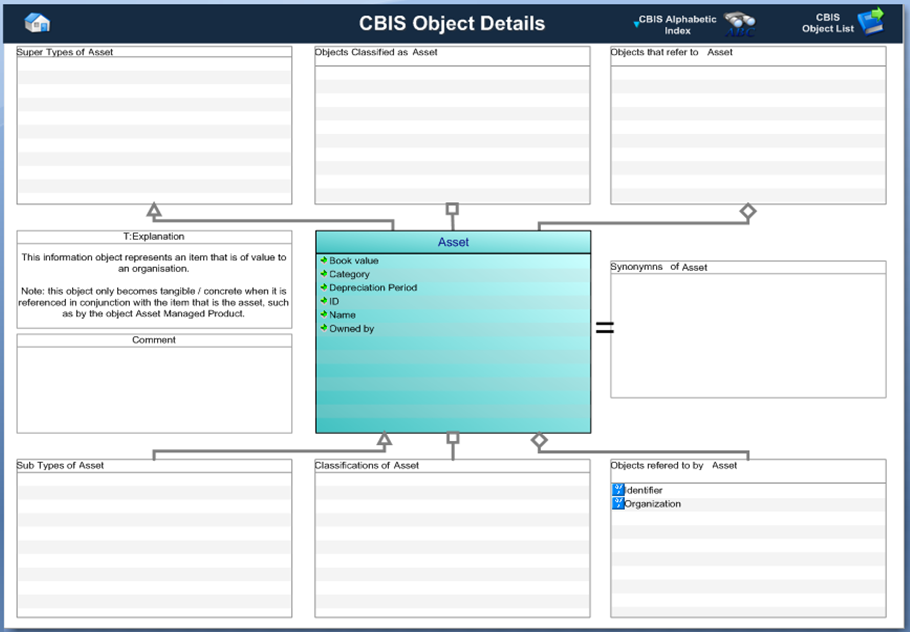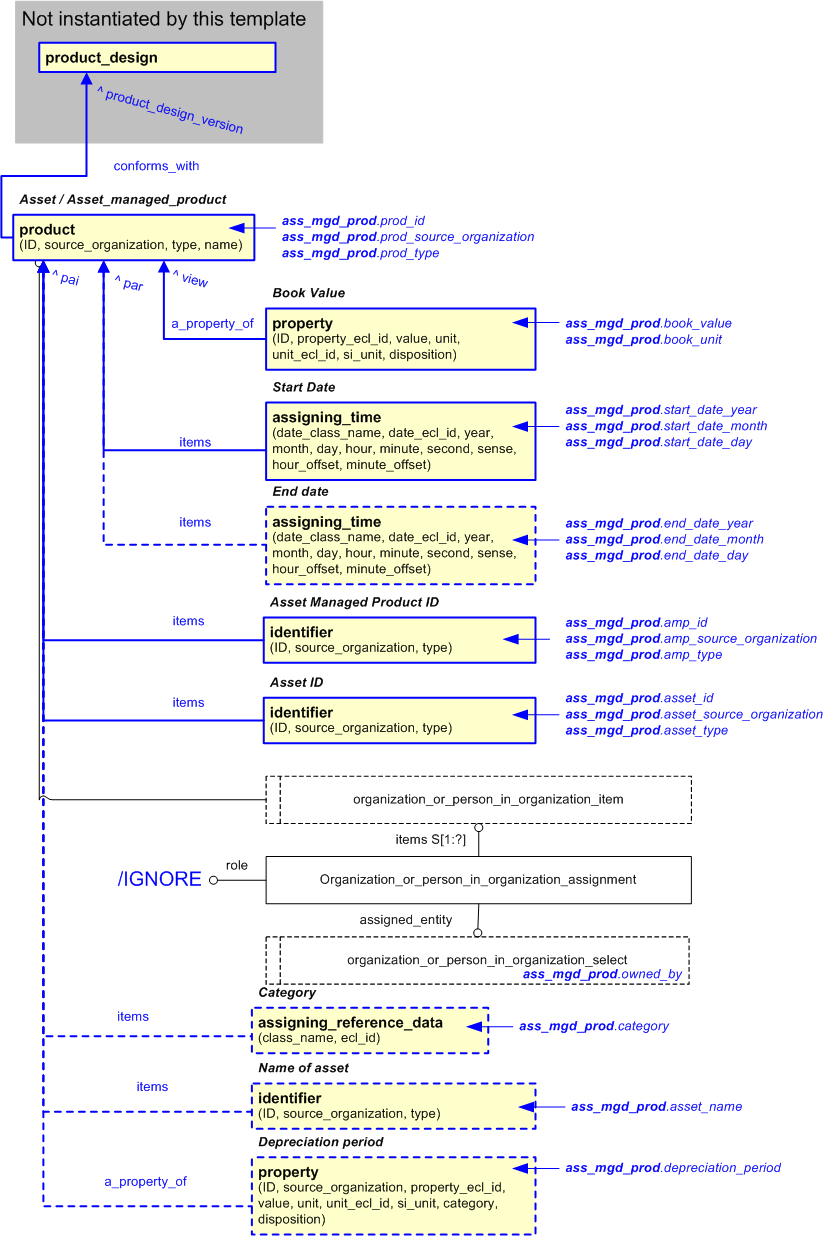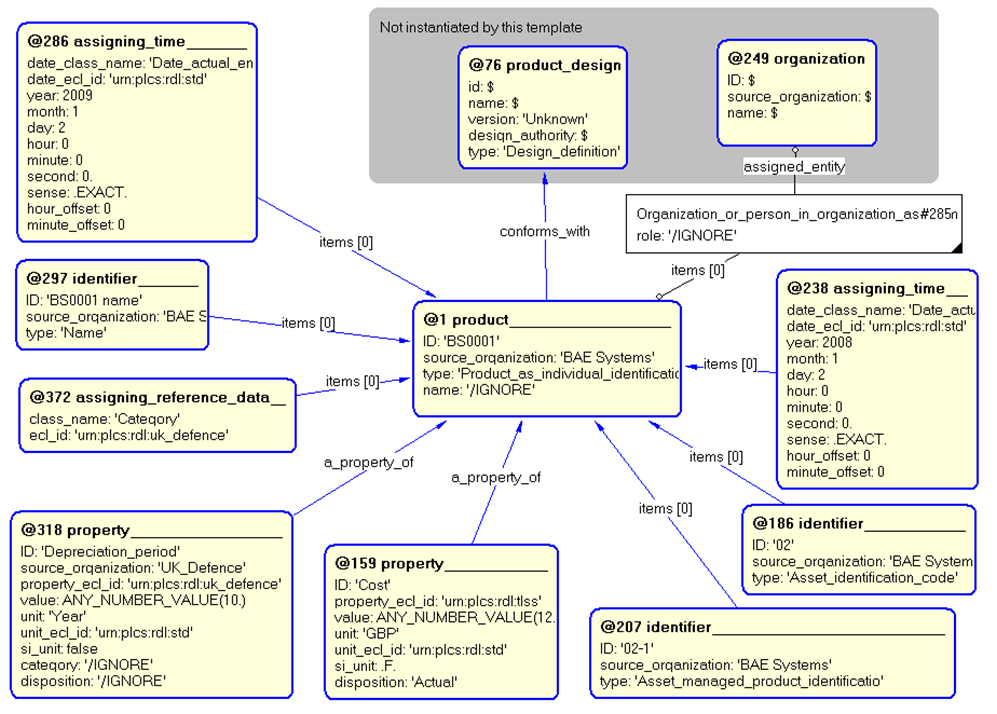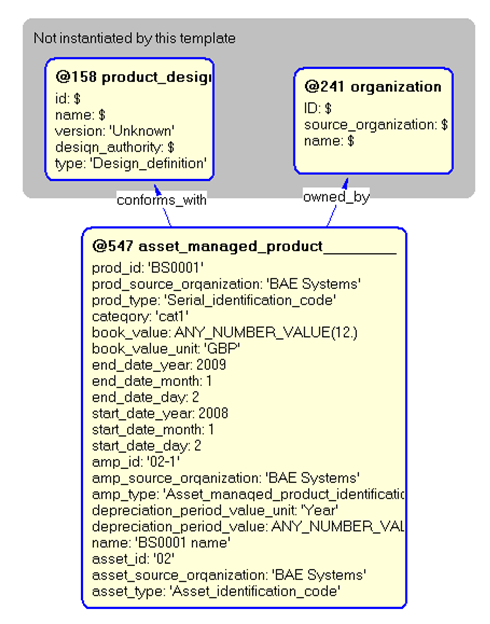Template:— asset_managed_product (ass_mgd_prod)
Context:— UK_Defence |
Date: 2009/10/30 15:49:23
Revision: 1.5
|
This section specifies the template asset_managed_product.
NOTE
The template has been defined in the context of
UK_Defence.
Refer to the business context for details of related templates.
NOTE
An explanation of a template and the associated instantiation path is
provided in the
Template overview
section.
This template describes how to represent a UK_Defence asset and asset managed product, using
Product.
This represents a product of value and managed in a specific manner for a defined period.
For further information about the representation of an asset managed product, see below.
This information object represents a product of value and managed in a specific manner for a defined period
Figure 1 — Graphical Representation for Business Object Asset Managed Product
Figure 2 — Graphical Representation for Business Object Asset
This template encompasses the requirements of a UK_Defence asset and asset managed product.
The definition of a UK_Defence Asset Managed Product object is:
This information object represents a product of value to an organization (asset) and managed in a specific manner
for a defined period.
The record consists of the attributes for a Product and those listed below (from Asset Managed Product and Asset).
|
Attribute name
|
Attribute description
|
Attribute type
|
Optionality
|
| End Date |
This is the date on which the related product ceased to be an asset for the asset owner |
Intrinsic |
Optional |
| ID identified as amp_id |
This is the identifier of the asset managed product |
Identifier |
Mandatory |
| Related Asset |
This is the reference to the asset for which the related product is the item of value |
Asset |
Mandatory |
| Related Product as prod_id |
This is the reference to the product which is the asset |
Product |
Mandatory |
| Start Date |
This is the date on which the related product became an asset for the asset owner |
intrinsic |
Mandatory |
| Book Value |
This is the present book value of the asset |
Intrinsic |
Mandatory |
| Depreciation Period |
This is the period over which the value of the asset depreciates to zero |
Intrinsic |
Optional |
| ID identified as asset_id |
This is the identifier of the asset, usually assigned by the owner of |
Identifier |
Mandatory |
| Name |
This is the name of asset. |
intrinsic |
Optional |
| Cateogry |
This is an indicator of whether the asset is currently possessed or whether it has been un-intentionally lost. |
intrinsic |
Optional |
| Owned by |
This is the reference to the owner of the asset |
Organization |
Mandatory |
Table 1 — Asset Managed Product attribute details
The EXPRESS-G diagram in
Figure
3
shows the templates and EXPRESS entities that are required
to represent the template
"asset_managed_product".
The text highlighted in blue shows the template parameters.
Figure 3 — An EXPRESS-G representation of the Information model for asset_managed_product
The graphic for the template to be used in other EXPRESS-G diagrams
is shown in Figure
4
below.
Figure 4 — The graphical representation of the asset_managed_product template
The following input parameters are defined for this template:
Current identifier of the product.
The organization that created the associated product identifier. Additionally
a Person or Information System could be defined when either of these are the source; see Identifier template characterizations
This is the name of the type of the class used to classify the product identifier and so
provide the role or reason for the identification.
The following classes and their sub-classes can be used:
This is an indicator of whether the asset is
currently possessed or whether it has been un-intentionally lost.
The following classes and their sub-classes can be used:
classifications: [Misplaced_product]![[warning:]](../../../../../../images/dex/warning.gif) Error RDL4: The URI urn:plcs:rdl:uk_defence is not listed in dexlib/data/refdata/rdl_index.xml[Product_in_possession]
Error RDL4: The URI urn:plcs:rdl:uk_defence is not listed in dexlib/data/refdata/rdl_index.xml[Product_in_possession]![[warning:]](../../../../../../images/dex/warning.gif) Error RDL4: The URI urn:plcs:rdl:uk_defence is not listed in dexlib/data/refdata/rdl_index.xml
Error RDL4: The URI urn:plcs:rdl:uk_defence is not listed in dexlib/data/refdata/rdl_index.xml
The value of the property.
The class name of the unit in which the value is expressed.
The following classes and their sub-classes can be used:
The organization that owns the asset.
Year_component of the date on which the related product ceased to be an asset for the asset owner
Month_component of the date on which the related product ceased to be an asset for the asset owner
Day_component of the date on which the related product ceased to be an asset for the asset owner
Year_component of the start_date that the asset was managed from
Month_component of the start_date that the asset was managed from
Day_component of the start_date that the asset was managed from
Current identifier of the asset_managed_product.
The organization that created the associated asset_managed_product identifier. Additionally
a Person or Information System could be defined when either of these are the source; see Identifier template characterizations
This is the name of the type of the class used to classify the asset_managed_product identifier and so
provide the role or reason for the identification.
The following classes and their sub-classes can be used:
The class name corresponding to the unit in which the period over which the value of the asset depreciates to zero
The following classes and their sub-classes can be used:
The period over which the value of the asset depreciates to zero.
The data type must also be indicated in this parameter, e.g.
"ANY_NUMBER_VALUE(5)".
name (Type='STRING', Optional)
Current identifier of the asset.
The organization or information system that created the associated asset identifier. Alternatively
this could be set to /NULL and when Person or Information System is the source; see Identifier template characterizations
This is the name of the type of the class used to classify the asset identifier and so
provide the role or reason for the identification.
The following classes and their sub-classes can be used:
The following reference parameters are defined for this template:
Allow the
Product_as_individual
entity instantiated in this path to be referenced when this template is used.
%^target = $asset_managed_product.pai%
Allow the
Product_as_realized
entity instantiated in this path to be referenced when this template is used.
%^target = $asset_managed_product.par%
%^target = $asset_managed_product.view%
The following parameter combinations specify a uniqueness constraint:
Unique constraint: Unique amp id
Each instance of the
entity
(
Product_as_realized)
within the data set shall be uniquely identified
by a combination of the following parameters on this
template (asset_managed_product) namely:
amp_id,
prod_id,
asset_id.
The
instance is
referenced by the following template parameter:
par.
The asset managed product identifier should only occur once in a data set.
Unique constraint: Unique asset
Each instance of the
entity
(
Product_as_realized)
within the data set shall be uniquely identified
by a combination of the following parameters on this
template (asset_managed_product) namely:
asset_id,
owned_by.
The
instance is
referenced by the following template parameter:
par.
The asset should only occur once in a data set.
The instantiation path shown below specifies the entities that are to be
instantiated by the template.
A description of templates and the syntax for the instantiation path is
provided in the
Templates Help/Information section.
-- instantiate the product -- Note it is assumed that the part is not versioned /
product(
conforms_with=@conforms_with,
ID=@prod_id,
source_organization=@prod_source_organization,
type=@prod_type,
name='/IGNORE')/
%^pai = $product.pai%
%^par = $product.par%
%^view = $product.view%
-- assign a book value property to the asset and classify it as 'Cost_property /
property(
ID='Cost_property',
property_ecl_id='urn:plcs:rdl:uk_defence',
value=@book_value,
unit=@book_value_unit,
unit_ecl_id='urn:plcs:rdl:std',
si_unit='.false.',
disposition='/IGNORE',
a_property_of=^view)/
-- instantiate a start date to the asset managed product /
assigning_time(
date_class_name='Date_actual_start',
date_ecl_id='urn:plcs:rdl:std',
year=@start_date_year,
month=@start_date_month,
day=@start_date_day,
hour='0',
minute='0',
second='0',
sense='.EXACT.',
hour_offset='0',
minute_offset='0',
items=^par)/
-- [OPTIONAL end date] /
assigning_time(
date_class_name='Date_actual_end',
date_ecl_id='urn:plcs:rdl:std',
year=@end_date_year,
month=@end_date_month,
day=@end_date_day,
hour='0',
minute='0',
second='0',
sense='.EXACT.',
hour_offset='0',
minute_offset='0',
items=^par)/
-- [optional Category] /
assigning_reference_data(
items=^par,
class_name=@category,
ecl_id='urn:plcs:rdl:uk_defence')/
-- instantiate assigning_identification for the asset's identification /
identifier(
ID=@asset_id,
source_organization=@asset_source_organization,
type=@asset_type,
items=^pai)/
-- instantiate assigning_identification for the asset managed product's identification /
identifier(
ID=@amp_id,
source_organization=@amp_source_organization,
type=@amp_type,
items=^pai)/
-- [OPTIONAL name] /
identifier(
ID=@name,
source_organization=@asset_source_organization,
type='Name',
items=^pai)/
-- [OPTIONAL depreciation period] /
property(
ID='Depreciation_period',
property_ecl_id='urn:plcs:rdl:uk_defence',
value=@depreciation_period_value,
unit=@depreciation_period_value_unit,
unit_ecl_id='urn:plcs:rdl:std',
si_unit='false',
disposition='/IGNORE',
a_property_of=^view)/
-- Instantiate Organization_or_person_in_organization_assignment entity Organization_or_person_in_organization_assignment-- Set the Organization_or_person_in_organization_assignment attribute role to be ignored Organization_or_person_in_organization_assignment.role = '/IGNORE'
-- Assign the Organization_or_person_in_organization_assignment to the AMP Organization_or_person_in_organization_assignment.items ->
^pai
-- Create the owned_by parameter Organization_or_person_in_organization_assignment.assigned_entity ->
@owned_by
The following entities are instantiated with attributes as specified:
The instance diagram in Figure
5
shows an example of the EXPRESS entities and templates that are instantiated by the template:
/asset_managed_product(prod_id='BS0001', prod_source_organization='BAE Systems', prod_type='Serial_Identification_code', book_value='ANY_NUMBER_VALUE(12)', book_value_unit='GBP', start_date_year='2008', start_date_month='1', start_date_day='2', end_date_year='2009', end_date_month='1', end_date_day='2', amp_id='02-1', name='BS0001 name', cateogry='cat1', depreciation_period_value='ANY_NUMBER_VALUE(10)', depreciation_period_value_unit='Year', amp_source_organization='BAE Systems', amp_type='Asset_managed_product_identification_code', asset_id='02', asset_source_organization='BAE Systems', asset_type='Asset_identification_code', conforms_with='@158', owned_by='@241')/
(an illustration of the consolidated asset_managed_product template is shown in
Figure
6 below.)
Figure 5 — Entities instantiated by asset_managed_product template
The instance diagram in
Figure
6
shows the graphic symbol for the template that is to be
used in other instance diagrams. The example template is:
/asset_managed_product(prod_id='BS0001', prod_source_organization='BAE Systems', prod_type='Serial_Identification_code', book_value='ANY_NUMBER_VALUE(12)', book_value_unit='GBP', start_date_year='2008', start_date_month='1', start_date_day='2', end_date_year='2009', end_date_month='1', end_date_day='2', amp_id='02-1', name='BS0001 name', cateogry='cat1', depreciation_period_value='ANY_NUMBER_VALUE(10)', depreciation_period_value_unit='Year', amp_source_organization='BAE Systems', amp_type='Asset_managed_product_identification_code', asset_id='02', asset_source_organization='BAE Systems', asset_type='Asset_identification_code', conforms_with='@158', owned_by='@241')/
Figure 6 — Instantiation of asset_managed_product template
Characterizations
No common characterizations of the template
asset_managed_product
have been identified. However, the ISO 10303-239 EXPRESS model
may enable other assignments to the entities instantiated by the template.
